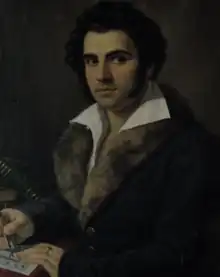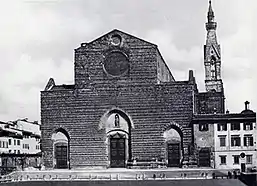Niccolò Matas
Niccolò "Nicola" Matas (6 December 1798 – 11 March 1872)[1] was an Italian architect and professor. He is best known for being the architect of the 19th century Gothic Revival façade of the Basilica of Santa Croce in Florence, Italy.[2][3] Matas was a professor at the Academy of Fine Arts, Florence (Italian: Accademia di Belle Arti di Firenze).[1] He is one of the important architects in the history of the city of Florence.[1][4]
Niccolò Matas | |
|---|---|
 painting by Pietro Benvenuti portraying Nicolò Matas, architect from Ancona (1798-1872) creator of the facade of the cathedral of Santa Croce in Florence | |
| Born | 6 December 1798 Ancona, Marche, Papal States (now Italy) |
| Died | 11 March 1872 Florence, Tuscany, Italy |
| Other names | Nicola Matas |
| Education | Academy of Fine Arts, Rome, Academy of Fine Arts, Venice, Accademia di Belle Arti di Vicenza |
| Occupation(s) | Architect, professor |
Early life
Niccolò "Nicola" Matas was born on December 6. 1798 in Ancona in Marche, Papal States (now present-day Italy).[1] His family was Jewish and of Spanish descent.[1] He studied at Academy of Fine Arts, Rome (Italian: Accademia di Belle Arti di Roma); followed by study at the Academy of Fine Arts, Venice (Italian: Accademia di Belle Arti di Venezia) and the Academy of Fine Arts, Vicenza (Italian: Accademia di Belle Arti di Vicenza).
Career
In 1825, Matas moved to Florence, where he was an academic professor at the Academy of Fine Arts, Florence (Italian: Accademia di Belle Arti di Firenze), primarily teaching architecture.[1] His architect contemporaries in Tuscany included Gaetano Baccani, Mariano Falcini, Emilio De Fabris, and Giuseppe Poggi.[4] Matas worked closely with sculptor Giovanni Dupré of Gipsoteca Dupré.[4] He had a working relationship with Anatoly Demidov, 1st Prince of San Donato.[1]
From 1857 to 1863, he worked on the design of the façade of Basilica of Santa Croce, where he worked in a prominent Star of David into the top of the building.[5][6] The design of the building was said to be influenced by a now-lost drawing by Simone del Pollaiolo, named "il Cronaca".[5] He is also thought to have been inspired by the Siena Cathedral (Italian: Duomo di Siena) and Orvieto Cathedral (Italian: Duomo di Orvieto).[7]
Matas died in Florence on 11 March 1872.[1] His body was moved in 1886, and Matas is buried under the porch at the Basilica of Santa Croce.[1][5]
There is a street named "Via Matas" in Ancona.
- Basilica of Santa Croce
 Santa Croce, Florence, prior to the design by Matas before 1857
Santa Croce, Florence, prior to the design by Matas before 1857_-_Facade.jpg.webp) Santa Croce, Florence, after the design by Matas after 1857
Santa Croce, Florence, after the design by Matas after 1857
Works
Restorations
- 1826, Bartolini Baldelli Palace (Italian: Palazzo Bartolini Baldelli), Florence, Tuscany, Italy, he restored the building.[8]
- 1834, Ancona Cathedral (Italian: Cattedrale di San Ciriaco), Ancona, Marche, Italy, he restored the building and the dome with copper
- 1836, Palazzo Della Ripa, Florence, Tuscany, Italy, he restored the building.[1]
New buildings or new portions of buildings
- 1835, Teatro delle Muse, Ancona, Marche, Italy, he worked on the building decorations.
- 1842, Dovizi Theater (Italian: Teatro dei Dovizi), Bibbiena, Tuscany, Italy.[9]
- 1857–1863, façade of Santa Croce, Florence, Tuscany, Italy.[6]
- 1851, Demidoff Gallery at Villa di San Martino, Elba Island, Portoferraio, Province of Livorno, Italy.[10][11]
- 1850–1855, Cimitero delle Porte Sante, near San Miniato al Monte, Florence, Italy
References
- Capalbi, Monica (2008). "Matas, Niccolò (Niccola, Nicola)". Treccani. Biographical Dictionary of Italians - Volume 72. Institute of the Italian Encyclopedia.
- "Niccolò Matas". Oxford Reference. Retrieved 2022-06-11.
- "Niccolò (Nicola) Matas". ChieraCoStui.com (in Italian).
- Poettinger, Monika; Roggi, Piero (2017-12-28). Florence: Capital of the Kingdom of Italy, 1865-71. Bloomsbury Publishing. pp. 50–51. ISBN 978-1-350-01399-5.
- Karpinski, Kate (2019-02-05). "Jewish Florence: synagogues, kosher cooking and cemeteries". The Florentine. Retrieved 2022-06-11.
- "Notes on the Façade of the Basilica of Santa Croce". St. Francis & the Americas, ASU. Retrieved 2022-06-11.
- Riccio, Letizia (2021-01-05). "4 chiese da visitare a Firenze | Artribune" (in Italian). Retrieved 2022-06-11.
- "Repertorio delle Architetture Civili di Firenze". Palazzo Bartolini Baldelli. Retrieved 2022-06-11.
- "Il Teatro Dovizi". Fondazione Giuseppe e Adele Baracchi Onlus. Archived from the original on 2014-07-14.
- Bacci, Mario Ettore; Battaglini, Giuseppe M.; Garfagnoli, Marino; Parigi, Mauro; Peria, Gloria; Vaccaro, Gianpiero; Zingoni, Lucia (2014). PORTOFERRAIO. Isola d'Elba (Guida turistica) (in Italian). Museum With No Frontiers, MWNF (Museum Ohne Grenzen). p. 142. ISBN 978-3-902966-06-3.
- Tonini, Maria Lucia (1996). I Demidoff a Firenze e in Toscana (in Italian). Florence, IT: Leo S. Olschki. p. 194. ISBN 978-88-222-4423-9.